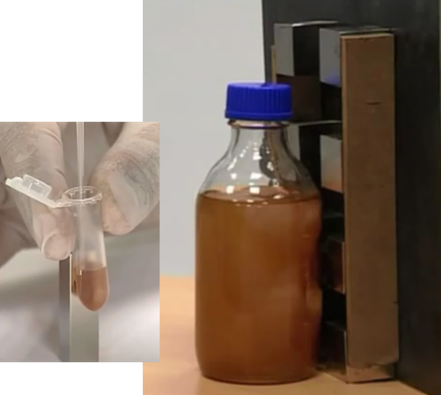When a lab has finally optimized their production process, they often link their process to a very specific piece of equipment and, by extension, have locked themselves into a constant volume. Often a lab develops its magnetic separation process for production with a specific magnetic separation device – this is normal. Usually the only parameter that needs to be adjusted during production is the separation time.

This post is about biomagnetic separation in the production of magnetic beads for IVD kits. If you want to know its most important elements, download our free ebook The basic guide to use biomagnetic separation in production processes:
Using non-homogeneous devices
If the biomagnetic separation device that is being used is non-homogeneous or if the conditions (parameters) are unknown, this process will not be reproducible when moving to a different device. The result of this is that there is a bottleneck in production because the lab has to determine how to optimize the production process on a different machine. This also often means that the lab has to run two duplicate lines for verification and quality control purposes until the new parameters are determined.
All of this costs extra time, effort and money, essentially negating the cost reductions realized when the production is scaled up. Therefore, it is very important that, when parameters are being defined, these are defined independently of the equipment. It is important to define parameters based on the properties of the material and the magnetic force, regardless of the vessel volume. By using a homogeneous biomagnetic separator like Sepmag, this becomes much easier.
Using homogeneous devices
If the parameters are equipment-independent and based on homogeneous conditions, changing the production process by scaling up or down does not need to include a bottleneck in production, but rather involves merely recalculating the separation time based on the speed of bead movement, since the magnetic force experienced by the beads is constant. Any new equipment should generate the same conditions. If this is true, separation time is merely a consequence of the distance the beads must travel. Standardizing parameters in this manner guarantees reproducibility of the process. It is much easier to link a production process to a technology that guarantees the same conditions no matter what size the batch or what volume of the vessel.
If you found this post about using biomagnetic separation for production useful, don't forget to check these related posts:
- Perfecting the magnetic separation process in magnetic bead IVD kit production
- Safety Risks using Magnetic Systems in production
- How to save space in the clean room
Check www.sepmag.eu/ebooks to access to FREE eBooks on the subject, or contact us. We will be glad to help you to achieve an efficient magnetic bead separation process!




